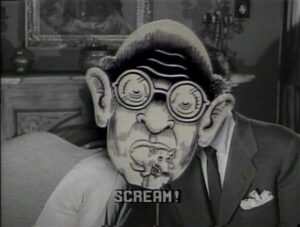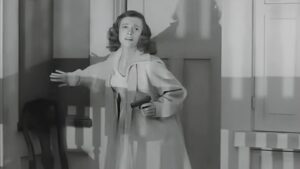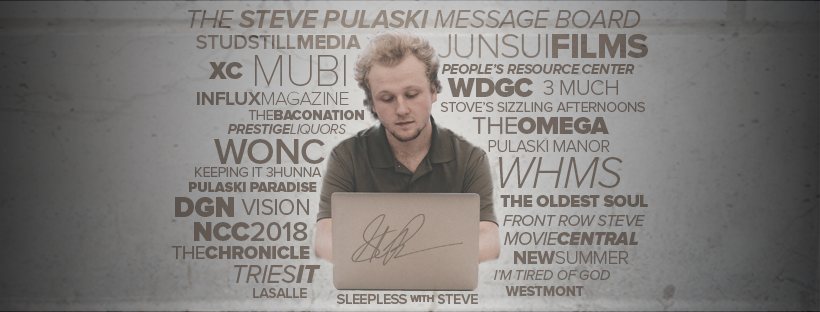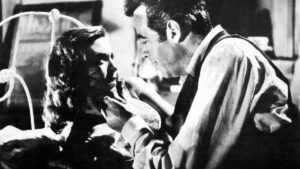Publication Date: 10-13-2025
My World Dies Screaming (1958) review
Dir. Harold Daniels
By: Steve Pulaski
Rating: ★★★
The real horror in Harold Daniels’ My World Dies Screaming — a seldom-remembered, let alone seen film from 1958 — emerges when you do more research into “Psychorama,” the curious and ultra-rare format in which the picture was shot.
To understand it is to go back to the 1950s, when concerns over subliminal messages in advertising were starting to arise. The idea that humans could be manipulated via moving images was still a new and fledgling concept for American audiences, who were starting to purchase televisions for their homes. My World Dies Screaming producer William S. Edwards was intrigued by the idea of Psychorama, also known as the “precon process” — the act of flashing images, text, or both on screen at the speed of a millisecond — and pondered about its use in the recently completed film.

Screening two separate versions of various clips from the film — one employing “subliminal messages” and the other, “exaggerated supraliminal symbols” visible to the naked eye (as utilized in the version of the film that exists today) — to a group of individuals from the FCC, the National Association of Broadcasters (NAB), and a film trade group, Edwards felt the concept had a great deal of potential. The NAB did as well. So, they went back and rewrote its Television Code to prohibit TV stations from employing subliminal projection in commercial advertisements. ABC, CBS, and NBC agreed with the ruling and banned their use.
That said, per Barry Atkinson’s book Atomic Age Cinema, Congress never took action to do the same. Across the vast spectrum of radio and television broadcasting, there is no law that abolishes “subliminally presented material.” No such law exists pertaining to film either. The United Kingdom, always quick to expose America’s shortcomings, intentionally or not, banned subliminal imaging in 1962. To date, only two films have utilized Psychorama: My World Dies Screaming (sometimes referred to by its “newer” title, Terror in the Haunted House), and Date with Death, both directed Harold Daniels.

The most shocking detail about My World Dies Screaming is it’s a solid chiller beyond the use of subliminal trickery. The story concerns Sheila (Cathy O’Donnell), who has been living in Switzerland for 17 years, battling vivid nightmares about a mansion owned by the Tierneys, a family she doesn’t know. She’s been seeing a therapist to little avail. Her husband, Philip (Gerald Mohr), decides to take her on a trip to Florida, where she happens to spot the very same mansion from her nightmares. Philip implores her that if the two of them were to stay at the home, she would see that there is nothing to fear. You must remember when watching this film that it was made during a time when women had such few rights that they couldn’t even bring themselves to ditch their husband when he insisted they stay at some creepy stranger’s mansions.
From there, the film is a briskly paced march towards greater mystery, and eventually answers, which are presented with minimal need for an external source for clarity. O’Donnell is sharp in her performance, channeling confusion and betrayal more-so than the helplessness of an otherwise ordinary damsel. The subliminal images in the film might seem corny upon further examination — IE: if you happen to pause on one of the stills — as they’re mostly sketches of cartoonish or demonic faces, some sporting words such as “DIE DIE DIE!” or simply, “SCREAM!” Viewed as part of the film, they help contribute to an uneasy atmosphere of sustained nervousness.
Shockingly little has been written about My World Dies Screaming, especially in the greater realm of 1950s horror. The relatively elusive nature of this picture suggests it has little to offer outside of its gimmicky use of subliminals. That might be the draw, but there is, in fact, an entire story here worth your time.
NOTE: As of this writing, My World Dies Screaming can be watched on YouTube, free of charge.
Starring: Cathy O’Donnell, Gerald Mohr, William Ching, John Qualen, and Barry Bernard. Directed by: Harold Daniels.
About Steve Pulaski
Steve Pulaski has been reviewing movies since 2009 for a barrage of different outlets. He graduated North Central College in 2018 and currently works as an on-air radio personality. He also hosts a weekly movie podcast called "Sleepless with Steve," dedicated to film and the film industry, on his YouTube channel. In addition to writing, he's a die-hard Chicago Bears fan and has two cats, appropriately named Siskel and Ebert!


